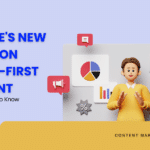
Google’s New Focus on People-First Content: What You Need to Know
November 8, 2023
How To Exploit Omnichannel Marketing For Better Reach
November 22, 2023How to Choose the Right Font for Your Marketing
Discover the art of font selection in marketing. Learn how typography shapes brand perception, the psychology behind fonts, and get practical tips.
Ever think about the hidden power of a font? It’s more than just stylish letters on a page. Fonts hold the power to shape initial perceptions, potentially tipping the balance in your favor or pushing it against you. It’s pivotal that your chosen lettering ensures your message isn’t just seen but truly understood.
Selecting the appropriate fonts is integral to a cohesive brand strategy, setting the tone and ensuring consistent messaging across all platforms.
Understanding Font Psychology
Every font speaks, though silently. It’s more than the mere design of letters; it’s the emotional undertone accompanying each word.
Consider Serif fonts, like Times New Roman. They’re not just letters; they’re statements of tradition, resonating with a sense of legacy and trust. Now, imagine sans-serif options like Arial. Their clean, unadorned lines signal a modern, straightforward approach, often appealing to those craving simplicity and transparency.
Luxury brands, from fashion to perfumes, frequently embrace Script fonts. Why? These characters, with their graceful curves, radiate elegance and premium quality. They’re the written equivalent of a VIP lounge or an exclusive event.
But then, some brands aim to disrupt, innovate, and electrify. They lean towards bold, contemporary typefaces, reflecting their zest and forward-thinking attitude. They’re the voice of the new generation, vibrant and unrestrained.
In essence, every print style holds an emotion, a backstory. For marketers, the challenge lies in aligning the story of a font with that of the brand. The right alignment creates a powerful synergy, making brands memorable and messages persuasive.
BRAND COLORS — EVERYTHING YOU NEED TO KNOW
Types of Fonts & Their Uses
Letter styles serve as silent ambassadors for a brand’s message. Each type tells its unique story.
- Serif Fonts: Think of Times New Roman or Georgia. With their small decorative lines, these character sets evoke feelings of tradition and reliability. They’re often seen in print materials and formal documents.
- Sans Serif Fonts: Helvetica and Calibri are popular examples. These character sets lack the decorative lines seen in Serif. Their clean lines signify modernity and clarity, making them a top choice for web content.
- Script Fonts: Characters like Pacifico and Brush Script transport readers to a world of elegance and creativity. They’re often used for invitations or logos of luxury brands.
- Display Fonts: Fonts designed to capture attention, like Bebas Neue or Impact, embody uniqueness. They’re great for headers or promotional materials.
- Monospace Fonts: Character sets like Courier New are technical and straightforward, often used in coding or to mimic typewriter text. They ensure every character occupies equal space.
Tips for Choosing a Font
Finding the perfect lettering for your project is more than just an aesthetic decision; it dramatically influences user experience and brand perception. The typeface you choose communicates subtle messages about your brand’s personality, mission, and values. Considering the entire font family is essential, ensuring you have versatile options for various contexts, from bold headlines to detailed body text.
Additionally, the design elements accompanying your chosen characters play a crucial role. Incorporating ample white space around your text enhances readability, ensuring your message doesn’t get lost in clutter. Lastly, always prioritize legibility. Letters that are easier to read will always triumph in conveying your message effectively to the audience.
When selecting a font, your choice shapes the reception of your message. Here’s what to weigh in:
- Target Audience: Know who you’re speaking to. A younger crowd might appreciate modern characters, while older audiences could favor traditional styles.
- Marketing Medium: A font that shines in print might falter on a digital ad. Always test your choice based on where it will appear.
- Brand Voice: Your font should match your brand’s tone. If your brand is playful, a formal style might not resonate.
- Readability: A beautiful font is only useful if it’s easy to read. Ensure it’s legible, especially in longer texts.
- Accessibility: Some fonts can be problematic for those with visual impairments. Choose characters that are friendly to all.
- Compatibility: Make sure your chosen font displays correctly across different devices and browsers. It ensures a consistent experience for all viewers.
Combining Fonts: Dos and Don’ts
Font pairing is an art. Done right, it can enhance your message. Here’s a guide to get it spot on:
- Complementary Fonts: Choose ones that harmonize. Pair a bold display font with a simple sans serif for balance. Contrast is key.
- Avoid Clashes: Steer clear of fonts that are too alike or jarringly different. It confuses readers and muddles your message.
- Number Rule: Stick to two or three styles—one for headings, one for body text, and maybe an accent font. Too many can be distracting.
- Hierarchy Matters: Ensure the fonts you select create a clear hierarchy. This guides readers smoothly through your content.
- Consistency is Key: Once you’ve chosen fonts, stay consistent. It builds brand recognition and keeps your material looking professional.
Remember, the right font combinations bolster your message and keep readers engaged. Choose wisely!
Font Size and Hierarchy
Font size isn’t just about legibility; it sets the stage for your content. Establishing a clear visual hierarchy ensures readers easily grasp your message.
- Visual Hierarchy: It’s essential for guiding the eye. Larger styles highlight key points, while smaller ones detail or expand upon them.
- Headings: Typically the most prominent text. Aim for bold, standout sizes that capture attention.
- Subheadings: Slightly smaller than headings, but still pronounced. They break up content, making it digestible.
- Body Text: The smallest style, but pivotal for comprehension. Ensure it’s clear and readable.
- Aesthetics and Functionality: While large styles can be striking, they must be functional. Balance is vital.
- Consistency Across Content: Use the same size guidelines for similar elements across your materials.
By using size to guide readers, you enhance their experience, making your content both engaging and informative.
Cultural and Regional Considerations
Typography isn’t one-size-fits-all. Respecting cultural nuances is paramount when selecting fonts, especially if you have a global brand.
- Cultural Nuances: Different scripts and typography styles have varied origins. A font that’s revered in one culture may be mundane in another.
- Global Resonance: Not every font has universal appeal. Due to historical or cultural associations, some fonts may not sit well with international audiences.
- Local Preferences: Regions often have distinct typography tastes. For instance, while clean, minimalistic styles might be popular in Western countries, intricate calligraphy-based fonts might be preferred in Middle Eastern nations.
- Avoiding Stereotypes: Using fonts that stereotype can offend. Always ensure your font choices respect and accurately represent a culture or region.
- Research is Key: Before finalizing a style for international marketing, research its reception in that region.
By valuing cultural nuances in typography, marketers show respect and mindfulness, ensuring their message is effectively and respectfully communicated.
Tools and Resources for Font Selection
Choosing the right font isn’t a shot in the dark; valuable tools can guide you.
- Font Pairing Tools: Online tools, like FontPair and TypeWolf, help match fonts that harmonize.
- Quality Font Downloads: Websites like Google Fonts and Font Squirrel offer a plethora of high-quality fonts for free.
- Previewing Your Choices: Tools like Fontjoy allow you to visualize chosen fonts in your design before finalizing.
With these resources at your fingertips, you can make informed and visually appealing character choices for your marketing needs.
Real-world Examples
Fonts can empower a brand’s image or diminish its impact. Let’s explore some real-world scenarios.
Success Stories:
- Coca-Cola: Their iconic cursive script, introduced in the late 1800s, exudes nostalgia and has become synonymous with the beverage giant. Its consistency in branding has made it one of the most recognized logos globally.
- Apple: Apple’s use of the San Francisco font, both sleek and functional, mirrors the brand’s ethos: modernity fused with user-friendliness.
Missteps to Learn From:
- Gap: In 2010, Gap briefly introduced a new logo, replacing its classic Spire font with Helvetica. This change met widespread criticism, and Gap swiftly reverted to its original.
- Tropicana: In 2009, Tropicana’s total redesign included a font change. The public’s confusion and displeasure led to a 20% fall in sales over two months. They returned to their original design posthaste.
From these examples, it’s evident that font choices profoundly affect brand perception. The key? Choose styles that reflect your brand’s core values and resonate with your target audience.
Font Wisdom for Impactful Branding
Selecting the right lettering isn’t mere aesthetics; it’s pivotal for brand perception. It’s the subtle communicator, whispering your brand’s essence to consumers. While the pull to follow trends is strong, grounding your choices in foundational principles ensures timelessness. Yet, there’s room for experimentation.
Let your brand breathe and evolve, but always keep its heart consistent.
Reflect on your typography. Does it resonate with your audience and reflect your brand? If there’s doubt, perhaps it’s time for a refresh. If the world of typography feels vast, we’re here to guide you. Reach out to Advent Trinity Marketing Agency for branding and design expertise. Elevate your brand’s voice today with a marketing strategy that literally speaks to your audience.




